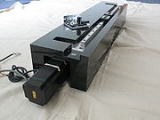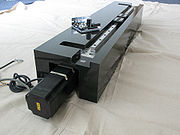
Epoxy granite
Encyclopedia

Mixture
In chemistry, a mixture is a material system made up by two or more different substances which are mixed together but are not combined chemically...
of epoxy
Epoxy
Epoxy, also known as polyepoxide, is a thermosetting polymer formed from reaction of an epoxide "resin" with polyamine "hardener". Epoxy has a wide range of applications, including fiber-reinforced plastic materials and general purpose adhesives....
and granite
Granite
Granite is a common and widely occurring type of intrusive, felsic, igneous rock. Granite usually has a medium- to coarse-grained texture. Occasionally some individual crystals are larger than the groundmass, in which case the texture is known as porphyritic. A granitic rock with a porphyritic...
commonly used as an alternative material for machine tool
Machine tool
A machine tool is a machine, typically powered other than by human muscle , used to make manufactured parts in various ways that include cutting or certain other kinds of deformation...
bases. Epoxy granite is used instead of cast iron
Cast iron
Cast iron is derived from pig iron, and while it usually refers to gray iron, it also identifies a large group of ferrous alloys which solidify with a eutectic. The color of a fractured surface can be used to identify an alloy. White cast iron is named after its white surface when fractured, due...
and steel
Steel
Steel is an alloy that consists mostly of iron and has a carbon content between 0.2% and 2.1% by weight, depending on the grade. Carbon is the most common alloying material for iron, but various other alloying elements are used, such as manganese, chromium, vanadium, and tungsten...
for better vibration damping, longer tool life, and lower assembly cost.
Machine tool base
Machine tools and other high-precision machines rely upon high stiffness, long-term stability, and excellent damping characteristics of the base material for their static and dynamic performance. The most widely used materials for these structures are cast iron, welded steel fabrications, and natural granite. Due to the lack of long-term stability and very poor damping properties, steel fabricated structures are seldom used where high precision is required. Good-quality cast iron that is stress-relieved and annealed will give the structure dimensional stability, and can be cast into complex shapes, but needs an expensive machining process to form precision surfaces after casting.Good-quality natural granite is becoming more and more difficult to find, but has a higher damping capacity than cast iron. Again, as with cast iron, the machining of natural granite is labour intensive and expensive.
Process

Threaded inserts, steel plates, and coolant pipes can be cast-in during the casting process. To achieve an even higher degree of versatility, linear rails, ground slide-ways and motor mounts can be replicated or grouted-in, therefore eliminating the need for any post-cast machining. The surface finish
Surface finish
Surface finish, also known as surface texture, is the characteristics of a surface. It has three components: lay, surface roughness, and waviness.-Lay:...
of the casting is as good as the mould surface.
Advantages and disadvantages
Advantages include:- Vibration damping.
- Flexibility: custom linear ways, hydraulic fluid tanks, threaded inserts, cutting fluid, and conduit piping can all be integrated into the polymer base.
- Inclusion of inserts etc. allows greatly reduced machining of the finished casting.
- Assembly time is reduced by incorporating multiple components into one casting.
- Does not require a uniform wall thickness, allowing for greater design flexibility of your base.
- Chemical resistance to most common solvents, acids, alkalis, and cutting fluids.
- Does not require painting.
- Composite has a density approximately the same as aluminum (but pieces are thicker to achieve equivalent strength).
- The composite polymer concrete casting process uses much less energy than metallic castings. Polymer cast resins use very little energy to produce, and the casting process is done at room temperature.
Epoxy granite material has an internal damping factor up to ten times better than cast iron, up to three times better than natural granite, and up to thirty times better than steel fabricated structure. It is unaffected by coolants
Cutting fluid
Cutting fluid is a type of coolant and lubricant designed specifically for metalworking and machining processes. There are various kinds of cutting fluids, which include oils, oil-water emulsions, pastes, gels, aerosols , and air or other gases. They may be made from petroleum distillates, animal...
, has excellent long-term stability, improved thermal stability
Thermal stability
Thermal stability is the stability of a molecule at high temperatures; i.e. a molecule with more stability has more resistance to decomposition at high temperatures....
, high torsional and dynamic stiffness
Stiffness
Stiffness is the resistance of an elastic body to deformation by an applied force along a given degree of freedom when a set of loading points and boundary conditions are prescribed on the elastic body.-Calculations:...
, excellent noise absorption, and negligible internal stresses.
Disadvantages include low strength in thin sections (less than 1 in (2.5 cm)), low tensile strength
Tensile strength
Ultimate tensile strength , often shortened to tensile strength or ultimate strength, is the maximum stress that a material can withstand while being stretched or pulled before necking, which is when the specimen's cross-section starts to significantly contract...
, and low shock resistance.
History
Although new to many machine tool builders, especially those in the United StatesUnited States
The United States of America is a federal constitutional republic comprising fifty states and a federal district...
, the composite base has been available in Europe
Europe
Europe is, by convention, one of the world's seven continents. Comprising the westernmost peninsula of Eurasia, Europe is generally 'divided' from Asia to its east by the watershed divides of the Ural and Caucasus Mountains, the Ural River, the Caspian and Black Seas, and the waterways connecting...
for several years. Fritz Studer AG of Switzerland
Switzerland
Switzerland name of one of the Swiss cantons. ; ; ; or ), in its full name the Swiss Confederation , is a federal republic consisting of 26 cantons, with Bern as the seat of the federal authorities. The country is situated in Western Europe,Or Central Europe depending on the definition....
first came up with its Granitan S-100 technology in the early 1970s. The Granitan base is a mixture of reactable epoxy-resin binder developed by Ciba-Geigy Ltd., Switzerland, and granite or gravel. Granitan produced with sand and gravel was developed specifically for the requirements of machine structure manufacturing.
Further reading
- Terry Capuano. "Polymer Castings take on metals". Machine Design 2006.http://machinedesign.com/article/polymer-castings-take-on-metals-0607

